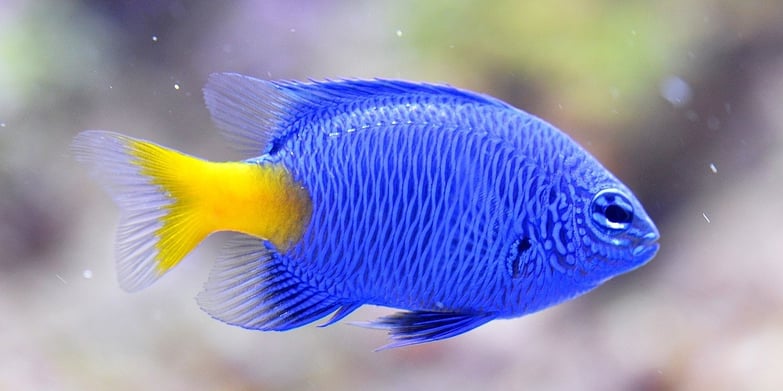
To keep your saltwater reef aquarium healthy, you want to maintain low phosphate levels. It's important to measure phosphates weekly in a reef tank because if the levels get too high (over .05 ppm) it can prevent coral calcification or cause excessive algae growth. (It's also a good idea to test the levels if you notice an excessive amount of algae in your tank.) The easy-to-use Hanna Marine Phosphate Ultra Low Range Checker® HC -HI774 generates accurate, digital readouts in parts-per-million (ppm) versus trying to judge traditional phosphate test kit color charts.
In addition to being easy and accurate, the full line of Hanna Marine Checkers eliminate the hassle of always having to buy new test kits. When you run low on the supplied packets of HI774-25 reagent, just purchase a refill pack and you are back to testing in no time.
How to Use the Hanna Marine Phosphate Ultra Low Range Checker® HC - HI774
Video: How to Use the Marine Phosphate ULR Checker - HI774 (2 minutes 23 seconds)
Note that the Hanna Marine Phosphate Ultra Low Range Checker® HC - HI774 gives readings in ppm.
To get readings in parts-per-billion (ppb) use our HI736 Ultra Low Range Phosphorus Colorimeter - Checker® HC.
- To convert from ppb phosphorus to ppb phosphate, multiply by 3.066.
- To convert the result to parts per million (ppm) phosphate, divide by 1,000.
Everything You Need to Start Testing
Our Marine Phosphate Ultra Low Range Checker® HC-HI774 is supplied as a complete test kit and retails for $49.95.
The kit includes:

- Hanna Marine Phosphate Ultra Low Range Checker® HC - HI774.
- Two sample cuvettes with caps.
- Phosphate Ultra Low Range reagent starter kit for 10 tests.
- One AAA Battery.
- The HI774 instruction manual and laminated quick reference guide. The reference guide includes the testing instructions and tips for accurate measurement. It’s the perfect companion to have while you are performing measurements.
How To Test:
The Hanna Marine Phosphate Ultra Low Range Checker is designed to make testing quick and easy.
- Press the button to power the meter on. When Add C1 appears on the screen, you are ready to begin testing.
- Fill a clean cuvette to the 10mL line with sample and fasten the cap.
- Using a microfiber cloth, wipe the cuvette to remove any oils or fingerprints from the glass. Then place the cuvette into the checker and close the lid. It's important to make sure that the lid is completely closed for an accurate reading.
- Press the button. Once the screen shows Add C2, remove the cuvette from the meter and add one packet of HI774-25 reagent.
- Fasten the cap, and shake gently for 2 minutes until the powder is completely dissolved. Then wipe the cuvette of any oils and fingerprints, and place back into the meter.
- Press and hold the button until the timer is displayed on the screen. The 3-minute countdown will begin. Once the timer reaches zero, the meter will automatically display the concentration of phosphate in parts-per-million (ppm).
Why Test for Phosphate?
While phosphate is essential for all life, it can be problematic for aquarium inhabitants – especially for coral, where excess phosphate can prevent calcification of the coral from happening. The main source of phosphate in reef aquariums is food, so care should be taken to avoid excess phosphates from feeding. Adding tap water to an aquarium can also lead to increased phosphate levels. Many municipalities have levels of phosphates in their water that are safe for human consumption, but can be detrimental to coral health.
Additionally, excessive algae growth , a lack of protein skimming, poor water change schedule, and the use of tap water will all contribute to high phosphate levels. Switching to reverse-osmosis deionized water (RO/DI) as a source for both topping off and making saltwater can help cut back on total phosphate levels in the aquarium environment. Utilizing a refugium to grow beneficial macro-algae can also help export phosphates in a reef aquarium. Using filter medias and chemicals, like granular ferric oxide (GFO) or carbon dosing, can help bind or utilize phosphates and remove them from the aquarium.
Although elevated phosphate levels in an aquarium can be damaging, a complete absence of phosphate is also not ideal. Phosphate is essential for tissue growth and tanks that lack it completely can develop problems. The ideal level of phosphate should be greater than 0 but less than 0.05ppm. Since so many factors are attributed to high phosphate levels, every aquarist should be testing for them on a regular basis.
The Limits of Traditional Color-Change Test Kits
The ideal phosphate level for reef aquariums is extremely low. Many other test kits on the market rely on a color change that needs to be judged by sight. These are notoriously difficult to use, especially in the lower ranges. The Hanna Marine Phosphate Ultra Low Range Checker® HC - HI774 bridges the gap between simple chemical test kits and professional instrumentation. The one-button design makes testing easier and more accurate by outputting a consistent digital reading every time.
Want to learn more about how accurate our Marine Checkers are? Check out the video below by our friends at Bulk Reef Supply, comparing our digital Checkers to a more expensive professional meter.
Video: Hanna Phosphate Checker Comparison by Bulk Reef Supply (10 minutes)
Use our Phosphate Comparison Chart to help you select the right Checker
Learn More About Our Full Marine Line of Checkers
- Hanna Marine Alkalinity (dKH) Checker HC - HI772 and Alkalinity (ppm) Checker HC - HI755 | Alkalinity Reagents HI755-26
- Hanna Marine Calcium Checker HC - HI758 | Calcium Reagents HI758-26
- Hanna Marine Ultra Low (ULR) Nitrite Checker HC - HI764 | Nitrite ULR Reagents HI764-25


